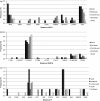Brazilian network for HIV Drug Resistance Surveillance (HIV-BresNet): a survey of treatment-naive individuals
- PMID: 29504269
- PMCID: PMC5835841
- DOI: 10.1002/jia2.25032
Brazilian network for HIV Drug Resistance Surveillance (HIV-BresNet): a survey of treatment-naive individuals
Abstract
Introduction: In Brazil, more than 487,450 individuals are currently undergoing antiretroviral treatment. In order to monitor the transmission of drug-resistant strains and HIV subtype distribution in the country, this work aimed to estimate its prevalence and to characterize the nationwide pretreatment drug resistance in individuals recently diagnosed with HIV between 2013 and 2015.
Methods: The HIV threshold survey methodology (HIV-THS, WHO) targeting antiretroviral-naive individuals with recent HIV diagnosis was utilized, and subjects were selected from 51 highly populated cities in all five Brazilian macroregions. The HIV pol genotypic test was performed by genomic sequencing.
Results: We analysed samples from 1568 antiretroviral-naive individuals recently diagnosed with HIV, and the overall transmitted drug resistance (TDR) prevalence was 9.5% (150 sequences). The regional prevalence of resistance according to Brazilian geographical regions was 9.4% in the northeast, 11.2% in the southeast, 6.8% in the central region, 10.2% in the north and 8.8% in the south. The inhibitor-specific TDR prevalence was 3.6% for nucleoside reverse transcriptase inhibitors (NRTIs), 5.8% for non-nucleoside reverse transcriptase inhibitors (NNRTIs) and 1.6% for protease inhibitors (PIs); 1.0% of individuals presented resistance to more than one class of inhibitors. Overall, subtype B was more prevalent in every region except for the southern, where subtype C prevails.
Conclusions: To the best of our knowledge, this is the first TDR study conducted in Brazil with nationwide representative sampling. The TDR prevalence revealed a moderate rate in the five Brazilian geographical regions, although some cities presented higher TDR prevalence rates, reaching 14% in São Paulo, for example. These results further illustrate the importance of surveillance studies for designing future strategies in primary antiretroviral therapy, aiming to mitigate TDR, as well as for predicting future trends in other regions of the globe where mass antiretroviral (ARV) treatment was implemented.
Keywords: HIV; HIV Drug Resistance Surveillance; HIV drug resistance; antiretroviral resistance; pretreatment HIV drug resistance; primary antiretroviral resistance.
© 2018 The Authors. Journal of the International AIDS Society published by John Wiley & sons Ltd on behalf of the International AIDS Society.
Figures



References
-
- Teixeira PR, Vitória MA, Barcarolo J. Antiretroviral treatment in resource‐poor settings: the Brazilian experience. AIDS. 2004;18 Suppl 3:S5–7. - PubMed
-
- Gagliani LH, Alkmim Maia WT, Sá‐Filho D, Janini LM, Sucupira MC, Caseiro MM, et al. The association between primary antiretroviral resistance and HAART virologic failure in a developing set. AIDS Res Hum Retroviruses. 2011;27(3):251–6. - PubMed
-
- Frentz D, Boucher CA, van de Vijver DA. Temporal changes in the epidemiology of transmission of drug‐resistant HIV‐1 across the world. AIDS Rev. 2012;14(1):17–27. - PubMed
Publication types
MeSH terms
Substances
Associated data
- Actions
- Actions
LinkOut - more resources
Full Text Sources
Other Literature Sources
Medical
Molecular Biology Databases

